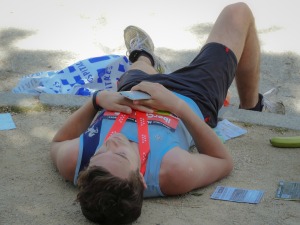I was busy cooking the other morning when it dawned on me: I must be a really boring person, because I always make the same breakfast (see photo above)!
It seemed, to my not quite fully awake mind, that a not so boring person would find all sorts of ways to make a healthy breakfast, whereas all I do is make the same healthy breakfast every morning. And I don’t need to be fully awake to do it.
Actually, when my mind started working a bit better, I realized that I have formed a breakfast habit: I make pretty much the same breakfast every morning, and it is a healthy breakfast. And since when I’m fully awake I’m pretty much always in “coaching mode,” it made me think of the need to talk about habits in relation to the oft-misunderstood concept of discipline. So here’s a post about that.
You see, when you have habits, you don’t need discipline.
Wait, no, let me re-phrase that a little:
When you have good habits, you don’t need very much discipline.
There, that’s better. But wait, don’t go yet; allow me to explain a little.
Habits
We all have them. There can be no doubt about that. Many, as a matter of fact.
Whether it is the side of the bed you sleep on, the time of day when you read your newspaper, how many hours per day you spend reading Facebook, the road you take to get to work every day, or what you eat on a typical day, these are only some of the habits you likely have.
I can almost hear you say “but, those are just routine things we do,” and you are correct. Because that is exactly what habits become: The routine, automatic things we do without really thinking about them.
It is true of things like breakfast, as I illustrated. Most of us eat the same thing day in, day out. It saves time, and it is efficient.
Many of you are probably tempted to respond that you don’t really have a choice in the matter, perhaps by providing the example of the route to get to work, which is what it is simply because of the origin and destination combination. I must, however, put a red light to that train of thought: If you think about it a little, except in some very specific situations, there is always a way to find alternate means and routes that, at some point, you decided against. Route choices were made at some point in time, and you’ve become comfortable with those decisions.
But you could choose to sleep on the other side of the bed, to not read Facebook at all, to read the newspaper at another moment of the day, to use a roundabout way to get to work. It might not be comfortable, and perhaps it would mean a longer transit time, and less recent information to discuss with colleagues at the water cooler (and in the case of Facebook, a lot more free time for other things), but it is possible.
Hence the inescapable conclusion that our lives are filled with habits that we accept. We simply could not function if we had to make every single decision about every action everyday. So we form habits.
The question is : Are they good habits, or bad habits? You see, the key to fitness and health becomes one of having more good habits than bad one.
Good or bad?
So, if you are still here, the idea is to have more good habits than bad ones.
Because I’m such a helpful kind of guy (that’s what good coaches are), I’m going to give you a few examples:
- Good: To move regularly, frequently. Every day, if possible, even it it is not very strenuously.
- Bad: To stay idle for too long, like sitting in a chair at the office.
- Good: To eat real food; meals made from fresh ingredients without extensive processing by machines.
- Bad: To drink calories, largely through pops, but also by consuming juices, milk, etc.
- Good: To get off the couch and do physical work around (and outside) the house on weekends, or just to go outside to play with the kids.
- Bad: To get on the couch and watch sports on TV on weekends, especially if accompanied by lots of liquid calories and NOT FOOD items.
- Good: To cook your own meals.
- Bad: To eat prepared meals, either bought in grocery stores (especially in the frozen aisles) or at restaurants (especially fast food restaurants).
- Good: To read this blog on a regular basis.
- Bad: To read Facebook for more than 30 minutes per day.
Ok, I think you are getting the point; even if I add a bit of humour around it, you know this is a serious matter.
But keep in mind that I’m talking about habits here. Once in a while, those “bad” behaviours are not a problem. They become a problem, however, when they are automatic, casual, and frequent actions. When that’s the case, something has to be done.
Discipline, what is it good for?
If you are like most folks, you are a little in awe of elite athletes. At the very least, you probably have some admiration for them, as well as for those who manage to train regularly.
You might be telling yourself something like “Wow! I wish I were that disciplined myself…”
At this point, you should begin to understand that training regularly is more a matter of having good habits than of having a strong self-discipline. With good habits, the behaviours that impress us the most are actually easy, because that are automatic!
But don’t get me wrong : This is not to say those athletes (and everyday athletes) we admire don’t have any discipline. They do. It is just that their discipline is used sparingly, and put to work where it works best.
If you try to apply discipline to make yourself do your training sessions, or eat better, you will run out of steam before very long. And you will fail. The good habits you seek will not be created.
You must first set your lifestyle, your daily and weekly routine, so as to make the good habits possible, instead of trying to wedge good behaviours into a routine that is not built to accommodate them. You must have a Purpose, and align your activities accordingly. Discipline comes a distant second, or even third if you include a good dose of motivation, towards building good habits that will serve your purpose.
Then, and only then, do you use discipline to eliminate bad habits. And to make sure you don’t go overboard in your training, like doing too much, too soon.
What does discipline at work look like?
You are tempted to read Facebook? Get up and go for a short walk. You feel like having yet another large coffee with lots of sugar and cream? Take a tall glass of water instead (and for crying out loud, don’t take it out of a plastic bottle!).
Simply put: Say “no” to the bad habit. You know how to recognize it when you see it…
If you use discipline to limit the behaviours you wish to do away with anyway, while you have set the stage for good habits to form, you stand a better chance of succeeding. At least, according to my life, and coaching, experience.
Saying “no” to the “free” pop with a meal or during a meeting at work, not picking up a fast food meal on your way home after work, or refraining from doing “just a few more kilometres” when in fact your training session is completed, that’s what discipline is good for.
The heavy lifting is done by establishing good habits, by being mindful of what your Purpose is, and setting the stage correctly. That Purpose might be something like “To be healthy and fit so as to live a long, active life” or it could be something else; what matters is that it must be explicit.
Choose your own, and be clear about it. Then set the stage for the good habits that will support your Purpose. And only then, when you really need it (and not all that often), use discipline to stay on course…
Photo credits: Sacha Veillette






